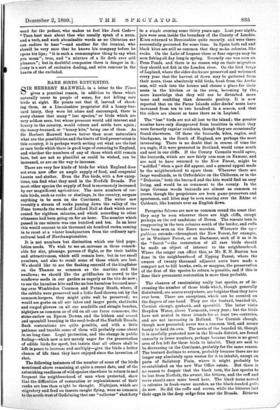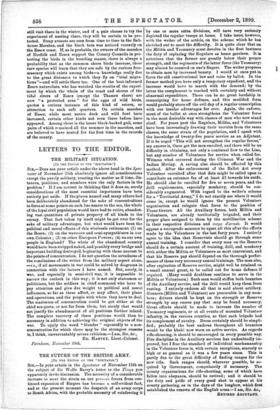RARE BIRDS RETURNING.
SIR HERBERT MAXWELL in a letter to the Times gives a practical reason, in addition to those which naturally occur to people a sense, for not killing rare birds at eight. He points out that if, instead of shoot- ing them, as a Lincolnshire proprietor did a honey-buz- zard lately, they were let alone and encouraged, there is every chance that many " lost species," or birds which are very seldom seen, but whose presence would add interest and beauty to the country, would return and settle here again ; the honey-buzzard, or "honey-kite," being one of them. As Sir Herbert Maxwell knows better than most naturalists what are the possibilities and the limits of bird preservation in this country, it is perhaps worth setting out what are the lost or rare birds which there is good hope of restoring to England, and whether the numbers of any of those which still remain here, but are not so plentiful as could be wished, can be increased, or are on the way to increase.
There are very few kinds of birds for which England does not even now offer an ample supply of food, and congenial haunts and shelter. Even the Fen birds, with a few excep- tions, can find what they need in the Norfolk Broads. For most other species the supply of food is enormously increased by our magnificent agriculture. The mere numbers of cer- tain birds, such as rooks or starlings, in the country, surpass anything to be seen on the Continent. The writer saw recently a stream of rooks passing down the valley of the Nene towards the woods of Lilford Hall at dusk which never ceased for eighteen minutes, and which according to other witnesses had been going on for an hour. The number which passed in one minute was one hundred and ten. In an hour this would amount to six thousand six hundred rooks, coming in to roost at a winter headquarters from the ordinary agri- cultural land of Northamptonshire.
It is not numbers bat distinction which our bird popu- lation needs. We wish to see an increase in those remark- able for size, plumage, powers of flight, or for their habits and attractiveness, which still remain here, but in too small numbers, and also to recall some of those which are lost. We should like to see the flashing emerald of the kingfisher on the Thames as common as the martins and the swallows ; we should like the goldfinches to crowd to the sunflower seeds in our garden as eagerly as the tits do now ; to see the harmless kite and the no less harmless buzzard soar- ing over Wimbledon Common and Putney Heath. where, if the rabbits were preserved and a little food thrown out by the common-keepers, they might quite well be preserved; we would see grebe on all our lakes and larger pools, shelducks and ringed plovers on all our sandhills and shingle beaches, nightjars as common as of old on all our furze commons, the stone-curlew on Epsom Downs, and the bittern and avocet and spoonbill breeding in the reed-beds of the Norfolk Broads. Such restorations are quite possible, and with a little patience and trouble some of them will probably come about in no long time. Legal protection, and the change in public feeling—which now is not merely eager for the preservation of edible birds for sport, but insists that all others shall be left in peace to increase and multiply—give the birds a better chance of life than they have enjoyed since the invention of shot.
The following instances of the number of some of the birds mentioned above remaining at quite a recent date, and of the astonishing readiness of wild species elsewhere to return to and frequent the neighbourhood of man when protected, show that the difficulties of restoration or replenishment of their ranks are less than might be thought. Nightjars, which are migratory and feed on insects caught flying, were so common to the south-west of Godalming that one " collector " shot forty
in a single evening some thirty years ago. Last year night. jars were seen inside the boundary of the County of London. Kites returned to Breconehire quite recently, and were there successfully protected for some time. In Spain both red and black kites are still so common that they make colonies, like rooks. On the Lake of Lugano three or four ospreys may be seen fishing all day long in spring. Recently one was seen on Penn Ponds, and there is no reason why on their migration they should not fish in the London river. On the bird bergs of Lapland, where the eider-ducks are preserved and welcomed every year that the harvest of down may be gathered from their nests, these absolutely wild birds, fresh from the Arctic seas, will walk into the houses and choose a place for their nests in the kitchen or in the oven, becoming by the. mere knowledge that they will not be disturbed more tame and confiding than domestic poultry. It is now reported that on the Fame Islands eider-ducks' nests have increased from ten to two hundred in a season, and that the eiders are almost as tame there as in Lapland.
The "lost" birds are not all lost to the island; the greater number have only disappeared from localities in which they were formerly regular residents, though they are occasionally found elsewhere. Of these the buzzards, kites, eagles, and blackgame, in the South of England, are perhaps the most interesting. There is no doubt that in course of time the sea eagle, if it were protected in Scotland, would come south and nest in our cliffs. If the County Councils would agree, the buzzards, which are now fairly corn mon on Exmoor, and are said to have returned to the New Forest, might be "notified "when a pair did appear, and a general appeal made to the neighbourhood to spare them. Wherever there are large woodlands, as in Oxfordshire on the Chilterns, or in the " Dukeries," both the buzzard and the kite would find an easy living, and would be an ornament to the county. In the large German woods buzzards are almost as common as crows, though the proprietors are keen game-preservers and sportsmen, and kites may be seen soaring over the Rhine at Coblentz, like kestrels over an English down.
Peregrine falcons are now so common round the coast that they may be seen wherever there are high cliffs, except perhaps on the red sandstone of Devon. The roseate tern is reappearing in the tern colonies south of the border, and ruffs have been seen on the Essex marshes. Wherever the ager publicus extends—throughout the New Forest, for example, or in Woolmer Forest, or on Dartmoor, such of it as is in the "forest "—the restoration of all rare birds should be made an object of interest to the neighbourhood. Where the ranger can effect this, as Mr. E. N. Buxton has done in the neighbourhood of Epping Forest, where the owners of twenty thousand adjacent acres have made a compact not to kill hawks, owls, or magpies, the preservation of the first of the species to return is possible, and if this is done their permanent restoration is more than probable.
The chances of recolonising really lost species, or of in- creasing the number of those birds which, though generally distributed, are scarce everywhere, are brighter than they have ever been. There are exceptions, whieh can be counted on the fingers of one hand. They are the bustard, bearded tit, Cornish chongh, goshawk, and spoonbill. The latter visits Breydon Water, above Yarmouth, every year ; but the birds have not nested in these islands for at least two centuries, and are not increasing in Holland. The Cornish chough, though now protected, never was a common bird, and seems barely to hold its own. The nests of the bearded tit, though it is carefully protected now in the Broads district, are found annually in fewer numbers, perhaps because there is no great area of fen left for these birds to inhabit. They are said to be decreasing on the Continent, probably for the same reason. The bustard declines to return, probably because there are no longer any absolutely open wastes for it to inhabit, except on parts of Salisbury Plain, where it might probably be re-established on the new War Office estate. But there is no reason to despair that the black tern, the last species to be lost from Norfolk, the avocet, the bittern, and the ruff and reeve should once more breed here. The black terns nested in colonies in fresh-water marshes, as the black-headed gulli do now. So did the ruffs and reeves, while the bitterns laid their eggs in the deep sedge-fens near the Broads. Bitterns still visit there in the winter, and if a pair choose to try the experiment of nesting there, they will be certain to be pro- tected. Stray avocets are seen from time to time in the Salt. house Marshes, and the black tern was noticed recently on the Essex coast. If, as is probable, the owners of the marshes of Norfolk and Essex support the County Councils in pro- tecting the birds in the breeding season, there is always a probability that as the common shore birds increase, these rare species will learn that they are safe by the curious free- masonry which exists among birds—a knowledge really due to the great distances to which they fly on "trial migra- tions "—and will settle there too. One of the best-informed Essex naturalists, who has watched the results of the experi- enent by which the whole of the coast and shores of the tidal rivers of Essex (except the Thames shore) are now "a protected area" for the eggs of wild birds, quotes a curious instance of this kind of return, or attraction to such safe quarters. On certain marshes of Essex, while most native duck and wild fowl have increased, certain other kinds not seen there before have appeared. Among these is the lesser black-backed gall, some pairs of which remained all the summer in the marshes, and are believed to have nested for the first time in the records of the county.























































 Previous page
Previous page